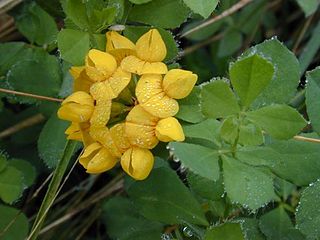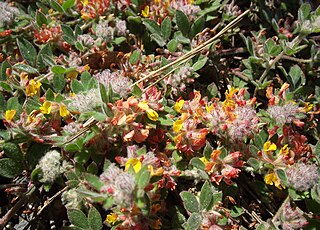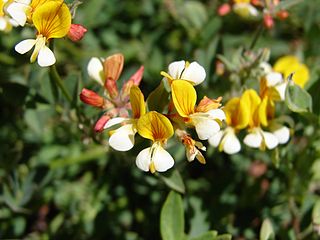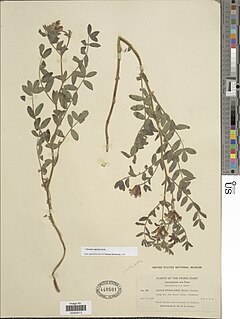
Lotus, a latinization of Greek lōtos, is a genus of flowering plants that includes most bird's-foot trefoils and deervetches and contains many dozens of species distributed worldwide. Depending on the taxonomic authority, roughly between 70 and 150 are accepted. Lotus is a genus of legumes and its members are adapted to a wide range of habitats, from coastal environments to high altitudes.

Lotus corniculatus is a flowering plant in the pea family Fabaceae, native to grasslands in temperate Eurasia and North Africa. Common names include common bird's-foot trefoil, eggs and bacon, birdsfoot deervetch, and just bird's-foot trefoil, though the latter name is often also applied to other members of the genus.

Lotus pedunculatus, the big trefoil, greater bird's-foot-trefoil or marsh bird's-foot trefoil, is a member of the pea family (Fabaceae).

Acmispon glaber is a perennial subshrub in the family Fabaceae. The plant is a pioneer species found in dry areas of California, Arizona, and Mexico. It is commonly found in many areas including chaparral, coastal sand and roadsides at elevations below 1500 m.
Hosackia crassifolia, synonym Lotus crassifolius, is a species of legume native to Washington, California and Oregon. It is known by the common names big deervetch and broad-leafed lotus.

Plebejus idas, the Idas blue or northern blue, is a butterfly of the family Lycaenidae.
Hosackia rosea, synonym Lotus aboriginus, is a species of legume native to North America. It is known by the common names rosy bird's-foot trefoil and thicket trefoil. It grows in mountains and canyons, often in moist areas. It is a perennial herb lined with leaves each made up of pairs of oval leaflike leaflets 1 to 3 cm long. The inflorescence is a spray of six to 10 white or pink flowers each about 1 cm long. The flower is somewhat tubular, encased at the base in a calyx of sepals and lobed at the mouth. The fruit is a hairless elongated legume pod 3–5 cm long.

Acmispon argophyllus, synonym Lotus argophyllus, is a species of legume native to California and northwest Mexico. It is known by the common name silver bird's-foot trefoil or silver lotus.
Acmispon argyraeus, synonym Lotus argyraeus, is a species of legume native to California and northwest Mexico. It is known by the common name canyon bird's-foot trefoil. It occurs in dry mountain habitat. It is a perennial herb lined with leaves each made up of a few oval leaflike leaflets about 1 cm long. Most of the plant is silky-hairy in texture. The inflorescence holds one to three pinkish-yellow flowers roughly 1 cm long. The fruit is a dehiscent legume pod up to 2.5 cm long.
Acmispon micranthus, synonym Lotus hamatus and Syrmatium micranthum, is a species of legume native to California and northwestern Mexico. It is known by the common name San Diego bird's-foot trefoil. It is found in the coastal mountain ranges of California and Baja California, where it grows in various types of scrub and canyon habitat. It is an annual herb taking a spreading or upright form. It is lined with leaves each made up of oval leaflets each about a centimeter long. The inflorescence is a small bunch of red and yellow flowers. Each flower is in a tubular calyx of sepals and is only a few millimeters long. The fruit is a narrow, bent legume pod up to 1.5 centimeters long, including the hooked beak at the tip.
Acmispon haydonii, synonyms Lotus haydonii and Syrmatium haydonii, is a species of legume native to California It is known by the common names pygmy lotus, rock bird's-foot trefoil and Haydon's lotus.

Acmispon heermannii is a species of legume (Fabaceae) known by the common names Heermann's bird's-foot trefoil and Heermann's lotus. It is native to the coastal plains, canyons, and mountains of California and Baja California, where it is known from several types of oceanside and inland habitat. It is a mat-forming perennial herb spreading straight stems along the ground. It is lined with leaves made up of several hairy oval leaflets. The inflorescence is a cluster of 3 to 8 flowers each up to about a centimeter long. The petals are yellow, often with dark lobes. The fruit is a curved, beaked legume pod.
Hosackia incana, synonym Lotus incanus, is a species of legume native to California. It is known by the common name woolly bird's-foot trefoil. It is endemic to the Sierra Nevada of California, where it grows in forests and other mountain habitat.
Acmispon prostratus, synonyms Lotus nuttallianus and Syrmatium prostratum, is a species of legume native to California and northwestern Mexico. It is known by the common names beach lotus, Nuttall's lotus, and wire bird's-foot trefoil. It is native to Baja California and just into San Diego County, California, where it is a resident of coastal habitats, such as beaches and bluffs.

Hosackia oblongifolia, synonym Lotus oblongifolius, is a species of legume native to western North America from Oregon to northern Mexico. It is known by the common name streambank bird's-foot trefoil or meadow lotus. It grows in moist to wet areas in several types of habitat. It is a spreading or upright perennial herb lined with leaves each made up of 3 elongated oval leaflets each up to 2.5 centimeters long. The inflorescence bears several yellow and white flowers between 1 and 2 centimeters long. The fruit is very elongated, reaching up to 5 centimeters in length but just a few millimeters in width.
Hosackia pinnata, synonym Lotus pinnatus, is a species of legume native to western North America from British Columbia to California. It is known by the common names meadow bird's-foot trefoil and bog bird's-foot trefoil. Its distribution extendsg into British Columbia in just a few rare occurrences near Nanaimo. It grows in moist to wet habitat, such as bogs and spring meadows. It is a hairless perennial herb lined with leaves each made up of green oval leaflets each 1 to 2.5 centimeters in length. The inflorescence is an array of up to 10 pealike flowers between 1 and 2 centimeters long. Each flower has a bright yellow banner, or upper petal, and white lower petals. The fruit is a slender, elongated legume pod up to 5 centimeters long but just a few millimeters long.

Acmispon maritimus, synonym Lotus salsuginosus, is a species of legume native to Arizona, California and northwestern Mexico. It is known by the common name coastal bird's-foot trefoil. It grows in many types of mountain, desert, and scrub habitat, not necessarily near the coast. It is an annual herb quite variable in morphology, from petite to bushy, hairless to roughly hairy, and prostrate to erect in form. The slender stems are lined with leaves each made up of pairs of leaflets variable in shape and size. The inflorescence is a small array of 1 to 4 yellow flowers, each up to a centimeter long or so. The elongated flower corolla emerges from a tubular calyx of sepals. The fruit is a legume pod up to 3 centimeters long. Laboratory studies have shown this species, which occurs in wildfire-prone habitat such as chaparral, to have an increased rate of seed germination after exposure to heat.

Hosackia stipularis, synonym Lotus stipularis, is a species of legume endemic to California. It is known by the common name balsam bird's-foot trefoil. It is found in most of the northern and central coastal and inland mountain ranges and foothills. It can be found in many types of habitat, including forest, chaparral, and disturbed areas. This is a mostly erect perennial herb with a leafy, often hairy and glandular form. Its slender branches are lined with leaves each made of several leaflets up to 2 centimeters long. The leaves sometimes have prominent stipules. The inflorescence is a compact array of up to 9 pink flowers. Each flower is elongated, the corolla borne in a tubular calyx of sepals, and the entire unit may exceed a centimeter long. The fruit is a legume pod 2 or 3 centimeters long containing several beanlike seeds.

Acmispon americanus, known by the common names American bird's-foot trefoil and Spanish clover, is a species of legume native to most habitats of California, the Western United States, Western Canada, and northern Mexico.












